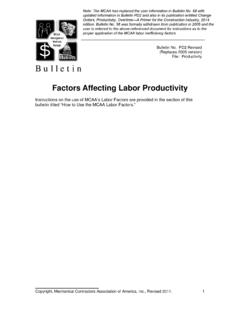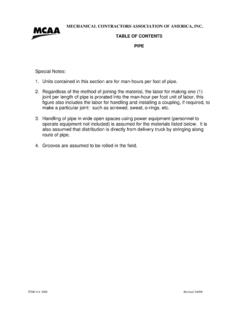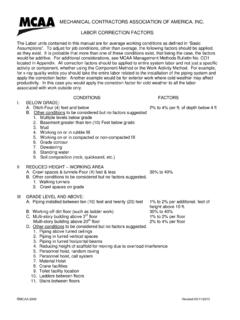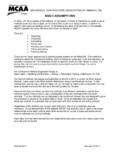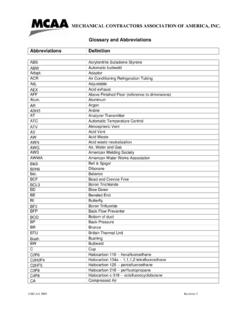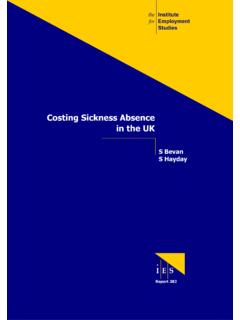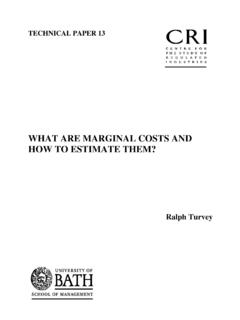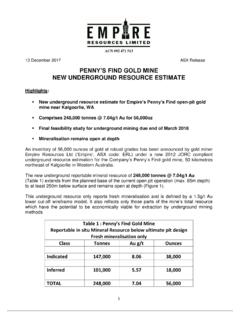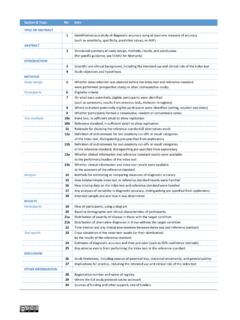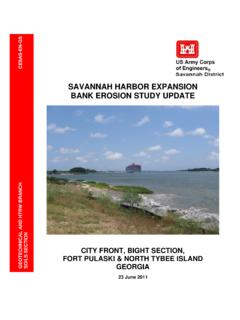Transcription of MCAA Management Methods Manual - WebLEM
1 B u l l e t i n Copyright, Mechanical Contractors Association of America, Inc., Revised 2011. 1 Bulletin No. OT1 Revised (Replaces 2005 version) File: Overtime How to Estimate the Impacts of Overtime on Labor Productivity Introduction The cost impact of unplanned extended overtime work1 may exceed the increased costs of the premium pay associated with an overtime work schedule. This impact comes in the form of reduced worker productivity as compared with the productivity of work performed on a straight-time basis. A mechanical contractor confronting significant periods of unplanned extended overtime work must consider the reduced productivity associated with working an overtime schedule. A number of published studies attempt to quantify the decrease in labor productivity associated with working extended overtime in the construction industry. This chapter will discuss the most frequently cited studies that have been used to quantify overtime labor inefficiency in the construction industry.
2 The chapter also will set forth some general guidelines for a mechanical contractor s consideration in assessing the labor inefficiency impact of unplanned extended overtime. The principles set forth in this chapter can provide meaningful guidance in estimating the loss of labor productivity arising from overtime in the forward pricing of change orders as well as in a retrospective application. Previous MCAA publications on overtime inefficiency included histograms that depicted loss of labor productivity data based on various overtime schedules. The histograms published in MCAA s Bulletin Nos. 18-A and 20 were based on the 1947 Department of Labor Bulletin No. 917, a study of prolonged overtime worked in the manufacturing sector. As several courts and commentators have recognized, the 1947 Bulletin No. 917 has limited application in the construction As a result, MCAA Bulletin Nos.
3 18-A and 20 have now been superseded by this version. This current publication is based on more recent studies that provide a basis of estimating labor inefficiencies utilizing data provided by construction contractors or from quantitative data actually measured on construction projects. Background Often mechanical contractors are directed by an owner or general contractor to accelerate the work for a variety of reasons. Acceleration can be achieved by adding crews, adding shifts, and/or working longer hours over and above 40 hours a week for the primary crew. This latter form of acceleration is known as overtime, and the direct costs of this process ( , the overtime payroll premium costs) are reasonably Copyright, Mechanical Contractors Association of America, Inc., Revised 2011. 2 easy to compute. However, the indirect effects of working an overtime schedule can be more difficult to quantify.
4 The primary indirect effect of working an overtime schedule is the loss of labor productivity by the workers performing the overtime work. The added cost in terms of the loss of labor productivity may, as noted above, exceed the direct payroll costs of supporting an overtime work schedule. The subject of this chapter is the added inefficiency costs of working overtime. While the MCAA has not prepared an empirical study within this chapter, the better- known overtime inefficiency studies have been revisited herein and compared, thus allowing the contractor to consider several sources of data in one set of tables. Overtime inefficiency is the most generally accepted category of labor inefficiency within the construction industry. That is true because virtually everyone who has worked extended hours executives, managers, technical and support personal, as well as the field labor forces have personally felt the reduced productivity effects of overtime schedules.
5 These effects can include fatigue, increased absenteeism, increased incidence of accidents, reduced morale, and a more negative work attitude. While many prime contractors and owners may be willing to pay the mechanical contractor s direct cost of overtime if the acceleration was not caused by the mechanical contractor s delay, the mechanical contractor is much more likely to be denied its inefficiency costs for the overtime schedule. It is essential for the mechanical contractor to establish a range of inefficiencies that may arise as a result of embarking on an overtime work schedule such that payment for the direct costs as well as the inefficiency costs can be reimbursed. This chapter seeks to provide the mechanical contractor with estimated inefficiency rates for various overtime schedules seen most frequently on construction projects. The percent inefficiency values offered herein are reasonable estimates of the inefficiency impacts that can be sustained by mechanical crews working various overtime schedules.
6 The inefficiency percentages are to be applied to all hours worked by a crew performing on an overtime schedule and not just the overtime The construction industry generally uses three terms to describe different overtime scenarios: shutdown or turnaround projects, spot overtime, and extended overtime. Shutdown or turnaround projects are those in which a system or plant is completely shut down for the project duration, and due to the production value of the system or plant, the construction schedule is highly compressed (often working 24/7 with multiple shifts) in order to minimize the duration of the shutdown. These working conditions are clearly understood during the bid/proposal process, and the contractor should include the associated inefficiencies in the mechanical contractor s bid or Spot overtime is short in duration (from as little as one day to a week) and is generally not planned in advance it is usually caused by a delay or other unanticipated event that requires the mechanical contractor to make up quantities or finish work that was not completed during the preceding Spot overtime is also normally worked by only a few crews at a time those responsible for the specific work scope in question.
7 The impact of working periodic and infrequent spot overtime is normally considered negligible in terms of inefficiency effects. As a result, spot overtime is not normally calculated in industry studies that attempt to quantify Copyright, Mechanical Contractors Association of America, Inc., Revised 2011. 3 the lost labor productivity due to unplanned extended overtime. Unplanned extended overtime is a condition wherein the entire project, or a significant portion of the project ( , all mechanical crews), work an overtime schedule for an extended period of time, sometimes without a planned return to a normal 40-hour week. Experience indicates that a return to a normal 40-hour schedule tends to reset the productivity of a crew, such that if the crew returns to an overtime schedule after a week or two of a normal schedule, the productivity loss would reset to that of the first week of overtime.
8 Thus, when utilizing any of the data provided herein, it is important to know the work schedule of the crews working overtime. If using a study that shows a progressively increasing loss of productivity over time, should a crew cease overtime and return to a straight time schedule, the crew s inefficiency upon resuming overtime work must be reset to normal production for the first measured period. Mechanical contractors should ensure that their bid or negotiated proposals clearly state that the base price for the work does not include any overtime, if in fact, no overtime was estimated. If overtime was estimated and its scope exceeds infrequent and limited spot overtime, an inefficiency factor should be included in the price for the work using a prospective estimate of inefficiency described in this chapter. As previously noted, this chapter does not offer an empirical study based on new overtime loss of productivity data.
9 Rather, this chapter reviews, analyzes, and summarizes four existing studies that have gained recognition in the construction marketplace and have been utilized to prove claims for overtime inefficiency. These studies are: 1) The November 1980 Business Roundtable publication entitled Schedule Overtime Effects on Construction Projects (hereinafter referred to as BRT ); 2) The 1989 study published by the National Electrical Contractors Association (NECA) entitled Overtime and Productivity in Electrical Construction (hereinafter referred to as NECA ); 3) The 1997 study published by Dr. H. Randolph Thomas of Penn State University, et al, entitled Schedule Overtime and Labor Productivity: Quantitative Analysis, published in the June 1997 Journal of Engineering and Construction Management , which was based on data included in a 1994 Report to the Construction Industry Institute entitled Effects of Scheduled Overtime on Labor Productivity: A Quantitative Analysis (hereinafter referred to as Thomas ); and 4) The July 1979 United States Army Corps of Engineers publication Modification Impact Analysis Guide, Publication No.
10 EP 415-1-3 (hereinafter referred to as the Corps ). These studies have been in use in the construction industry for many years and have been generally accepted as reliable measures of lost productivity due to unplanned extended Each has its strengths and weaknesses, including criticisms ranging from the use of limited data sources to the withdrawal of reports from However, the baseline data in any of these studies have never been proven to be inaccurate. Moreover, the concept that a contractor s work force becomes less efficient as unplanned extended overtime is worked is generally recognized and has never been disproved as an underlying fact. Copyright, Mechanical Contractors Association of America, Inc., Revised 2011. 4 The four studies presented in this chapter as a basis for estimating a contractor s loss of labor productivity show striking similarities in their results.
